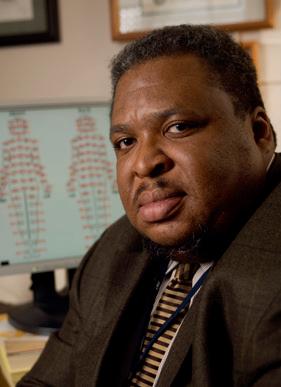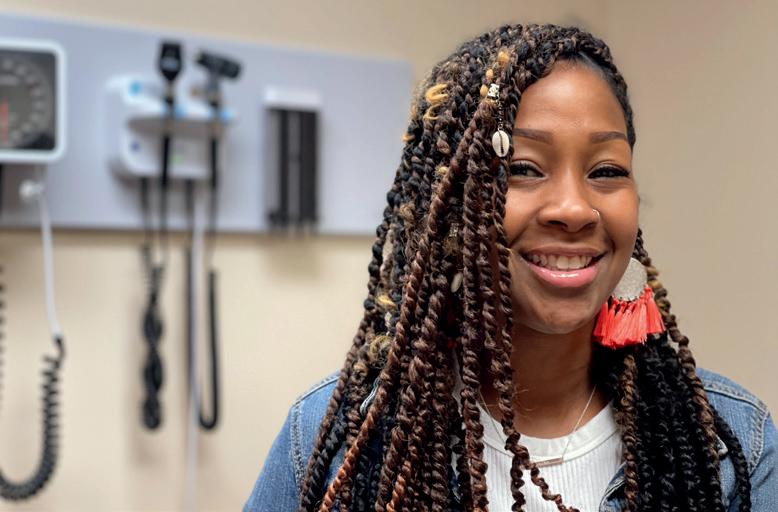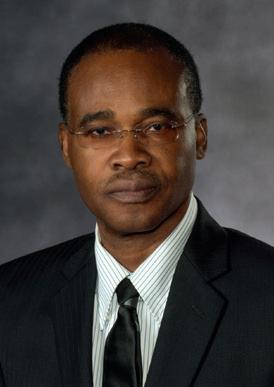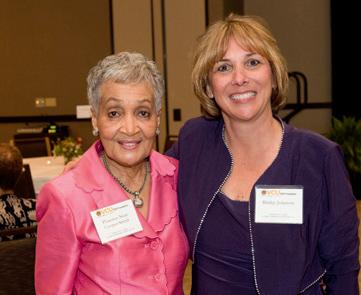
17 minute read
Orphans in Need
from NEXT | Summer 2021
Orphans
VCU Health’s leadership in sickle cell disease care and research provides a national model for how to address disparities and quality of care.
in Need

By Paul Brockwell Jr.


Wally Smith, M.D., professor and scientific director of the VCU Center on Health Disparities, directs VCU’s Adult Sickle Cell Medical Home. Photo courtesy VCU Public Affairs
The trouble usually starts around six months after birth. By that point, children born with sickle cell disease have stopped producing fetal hemoglobin, and the first symptoms begin. Hemoglobin is the oxygen-carrying protein inside red blood cells. In sickle cell disease, a minor DNA mutation produces red blood cells that have sickle hemoglobin, an abnormal hemoglobin that cannot carry oxygen as well as regular hemoglobin. When it releases oxygen, sickle hemoglobin proteins link together to form long, unbendable polymers inside the red blood cell. These polymers stretch the red blood cells out of their usual donut shape into abnormal sickle or crescent-shaped cells that no longer move through the body’s blood vessels, slowing and stopping blood flow.
Chaos ensues all over the body. Organs no longer receive oxygen. Pain begins, and sickled red blood cells break open and die, spilling poisonous waste into the body. This vicious cycle continues. Less oxygen means more hemoglobin polymers, and in turn more clogged blood vessels, more red blood cell death, more pain and more anemia. Eventually, massive tissue and organ damage and a weakened immune system shorten the lifespan of many patients who experience painful crises that become chronic, with frequent emergency room visits, failing organs and a sense of helplessness.
For too many years, the medical community and society abandoned these patients who, in the U.S., are predominately Black. Many doctors threw up their hands and told children and parents not to worry about making life plans or attending school, since they likely would not live long past their 20th birthday. Those lucky enough to survive were told there was little to do for them other than to give them opioids. And doctors were also stingy with opioids, leaving patients in pain for fear of turning them into addicts. Similarly, most researchers overlooked the disease. Almost all of society stigmatized patients with the condition.
The exact prevalence of SCD remains unknown. The Centers for Disease Control and Prevention estimates that it occurs in approximately one out of every 365 births of Black or African American individuals in the U.S. Researchers estimate around 100,000 individuals suffer
from SCD in the U.S., making it the most common inherited blood disorder. Millions worldwide are born with SCD.1 Even so, patients with hemophilia and cystic fibrosis, which when combined are still less common than SCD, have far more access to comprehensive care. SCD is thus the paragon of a disparities disease. For comparison, cystic fibrosis affects fewer than half the number of persons but receives 3.5 times the funding from the National Institutes of Health and 440 times the funding from national foundations.2
“In November 2020 the National Academies of Science, Engineering, and Medicine (NASEM) formally declared sickle cell disease as a disparities disease, in an exhaustive 500-page report filled with recommendations for federal funders, foundations, industry and private philanthropy,” said Wally Smith, M.D., professor and scientific director of the VCU Center on Health Disparities. “The NASEM report is the bible we’ve been waiting for to outline how the U.S. should treat SCD patients equitably.”
Since the 1970s, research and clinical advances no longer make SCD a death sentence. On the MCV Campus, a strong, five-decade-long history of outreach and research has made VCU Health a leader. It started in 1972, when Congress passed the National Sickle Cell Disease Control Act. The law provided the first-ever authority to set up education, screening, research and treatment programs for SCD.3 VCU started one of the first efforts to screen all newborns in Virginia for sickle cell disease, thanks to the leadership of Robert Scott, M.D., and Florence Neal Cooper Smith.
“VCU was in the unique position of being one of the first 19 institutions to have a sickle cell disease outreach program in 1972,” Dr. Smith said. “Florence Neal Cooper Smith and Dr. Robert Scott started the clinic in the face of overwhelming opposition. They were swimming upstream the whole time. Now people look to us as authorities in this area. We are clearly one of the top 10 centers in the country — whether you measure by number of patients, funding from the federal government or industry, or research productivity.”
Thanks to groundbreaking research and advances in care, children with SCD are now surviving well into adulthood. The resulting adult population growth underscores the need for new investment in research and patient care for this expanding patient population. Dr. Smith directs VCU’s Adult Sickle Cell Medical Program, which now cares for nearly 700 patients, three times as many as when he arrived on the MCV Campus in 1991. VCU Health currently serves SCD patients from across Virginia, intentionally reaching and educating patients and providers as far away as the Eastern Shore.
Sickle Cell Disease
Normal red blood cell
When it releases oxygen, sickle hemoglobin proteins link together to form long, unbendable polymers inside the red blood cell. These polymers stretch the red blood cells out of their usual donut shape into sickle or crescent-shaped cells that carry oxygen less efficiently and no longer move through the body’s blood vessels, slowing and stopping blood flow. Normal hemoglobin
Sickle cells blocking blood flow
Sickle cell
Abnormal hemoglobin
PATIENT PERSPECTIVE
Family Care for All Life’s Stages

Jennifer Folsom was six months old when doctors diagnosed her with sickle cell disease. Since receiving that life-changing news, she has grown up knowing that her condition requires caution and careful monitoring. As a kid, she would always think twice before engaging in team sports for fear the strenuous activity could potentially cause complications, and she often had to educate adults around her about sickle cell disease and how it affects her.
Originally from Delaware, Folsom and her family moved to Virginia after her father’s death when she was in elementary school. Since then, she’s been a patient in VCU Health’s sickle cell programs, transitioning at 19 from the pediatric care team to the adult sickle cell program led by Wally Smith, M.D. Dr. Smith and his patient navigators count nearly 700 patients in the adult sickle cell program.
The transition from pediatric to adult sickle cell care can be rough. Research shows persistent challenges with adequate access to treatment, especially to physicians who understand and can treat patients with the condition. Thankfully, Folsom says her experience at VCU Health has been overwhelmingly positive.
“My transition was smooth,” Folsom said. “My pain changed as I grew older, and finding the right medication was a concern, but it wasn’t a hard transition.”
Access to health care professionals who understand her condition and advocate for her health has been a hallmark of Folsom’s experience, including after-hours calls and quick efforts to ensure key prescriptions are available to manage her disease and reduce emergency room visits and hospitals stays.
“I have never felt like I was alone,” Folsom said. “My care team has always had my back. If I had to reach out to someone, even before the patient portal was operational, I could contact them directly. It feels more like a family — everyone knows everyone, and they ask how we’re doing to make sure we are doing OK.”
Folsom, a parent of two, considers herself fortunate because the reality for too many sickle cell adult patients remains more challenging. Growing up, she said people didn’t understand what sickle cell was and how it affects people with recurring pain and other complications. She has lost jobs due to the chronic nature of her condition, but she also has a hopeful outlook when sharing challenges she’s faced. At VCU Health, she says she feels seen and heard for who she is as a patient, and the care received has enabled her to live her life and enjoy her career as an aesthetician as she hopes, one day, for a cure through research.
“Not every day is going to be sunshine and rainbows,” Folsom said, “but my doctors and nurses are working to make sure I am able to do what I want to do, and their investment in my progress means a lot.”
Photo: Paul Brockwell Jr.
The advances in pediatric SCD care have largely not translated to advances and better outcomes for adults with sickle cell disease. Care remains poor in many parts of the U.S., which in turn leads to a higher need for acute care and hospitalizations, and paradoxically worsening mortality for patients.4 That’s the professional challenge and calling that Dr. Smith has been pursuing since 1984.
“I saw orphans needing a home,” Dr. Smith said. “There’s a whole generation of Americans who don’t remember the days when sickle cell patients were not living to adulthood. They don’t understand how much we have had to go through to get care to where it is today.”
His efforts fall into three major categories: developing and testing new treatments, understanding and removing barriers to care in order to improve health outcomes for patients, and advocating with policymakers at the local, state and national level to achieve equity in funding and equitable lifespans for adults with SCD.
RESEARCH AND TREATMENT DEVELOPMENT In addition to his clinical duties, Dr. Smith consults on a drug development project based at the VCU School of Pharmacy. He’s working with Martin K. Safo, Ph.D., professor in the school’s Department of Medicinal Chemistry, to develop compounds that help improve the oxygen-carrying capacity of red blood cells in sickle cell patients and destabilize the polymers from causing further sickling, which in turn instigates the pain and other chronic and potentially life-threatening issues experienced by patients.
“This is a team effort,” said Dr. Safo, who is affiliated with the School of Pharmacy’s Institute for Structural Biology, Drug Discovery and Development. “We have spearheaded global efforts over the past four years to develop new compounds to treat sickle cell disease with partners like Dr. Osheiza Abdulmalik at the Children’s Hospital of Philadelphia and King Abdulaziz University in Jeddah, Saudi Arabia.”
Dr. Safo has been working on drug discovery for sickle cell for almost 30 years. Originally from Ghana, he knows firsthand how the disease can affect people. Two of his cousins were born with sickle cell, and one has already died from the disease. He earned his doctorate in inorganic chemistry before being inspired to pursue sickle cell research with the late Donald Abraham, Ph.D., who was the Alfred and Francis Burger Emeritus Professor of Medicinal Chemistry and Biological Chemistry, and Emeritus Director of the Institute for Structural Biology and Drug Discovery at VCU. Dr. Abraham died in April.
Their early efforts explored the potential of vanillin, an aromatic aldehyde, which is the primary component of vanilla extract. Early studies were promising, but ultimately the naturally occurring compound was not potent enough and lacked the pharmacokinetic properties to make an impact in patients. Dr. Safo’s independent research also found promise in the byproduct of a sugar molecule named 5-HMF. In studies, this compound was five times more potent than vanillin at increasing the concentration of the non-polymerizing oxygenated sickle hemoglobin. Dr. Safo and his team took the research far enough to license the compound to a pharmaceutical company to produce for clinical trials. That company, unfortunately, went bankrupt and future studies stalled, but Dr. Safo and his team had managed to change the paradigm on exploring potential therapies.
Additional research on potential compounds put VCU Health at the forefront of sickle cell disease drug discovery among aromatic aldehydes.5 During this time, a private company, Global Blood Therapeutics, built off of VCU researchers’ published compounds to produce a similar compound that they tested and brought to market. That drug, voxelotor, was approved in 2019 as only the second new therapeutic authorized for use in SCD patients in the 21 years since hydroxyurea, an antimetabolite used to slow the growth of certain types of cancer, was authorized by the FDA for treatment of SCD.
The VCU Health team continues to explore and improve potential treatments. Their latest promising work is a compound named VZHE-039, a novel anti-sickling agent that the team hopes to advance for clinical trials in the next year. Unlike therapies currently on the market, this new compound designed on the MCV Campus works on two levels: first, it increases the concentration of the non-polymerizing sickle hemoglobin; second and uniquely, it directly destabilizes the sickle hemoglobin from forming polymers, thus preventing further sickling and reducing the risk of pain and organ damage downstream.6 The candidate is rapidly advancing toward Phase I/II clinical trials.
“Our compound is rather unique,” Dr. Safo said, “The dual anti-sickling activities of VZHE-039 would be critical to successfully ameliorate the disease phenotype in areas of severe hypoxia. For instance, voxelotor-bound sickle hemoglobin may still be incorporated into fibers, whereas VZHE039-bound sickle hemoglobin would destabilize polymer formation.”


Martin Safo, Ph.D., professor in the VCU School of Pharmacy’s Department of Medicinal Chemistry, has been leading efforts on the MCV Campus to develop new treatments for sickle cell disease. Photo courtesy VCU Public Affairs
Martin Safo, Ph.D. Professor, Department of Medicinal Chemistry VCU School of Pharmacy
This spring, the team received funding from the National Institutes of Health to continue the effort to develop this new treatment. One thing has changed, however. After their earlier experiences with licensing to a company stalled progress, the researchers formed their own company, IllExcor Therapeutics, to develop the compounds coming from research being conducted at VCU for the treatment of SCD. The name is a combination of the word “ill” and a shortening of the word exorcism, a clarion statement of the company’s purpose.
“We have a lot of hope that these therapies will be a huge benefit,” Dr. Smith said of the team’s efforts. “And that this compound can be added to the arsenal of potential tools. It’s very encouraging. I would say that the future is bright right now. Our biggest challenge remains awareness.”
If you would like to support sickle cell disease research and care on the MCV Campus, please consider making a gift to the Florence Neal Cooper Smith Professorship by contacting Brian Thomas, MCV Foundation vice president and chief development officer, at 804-828-0067 or brian.thomas@vcuhealth.org.
1. Centers for Disease Control and Prevention. “What is Sickle Cell Disease?” www.cdc.gov/ncbddd/sicklecell/facts.html
2. Lee, L.; Smith-Whitley, K.; et al. “Reducing Health Care Disparities in Sickle Cell Disease: A Review.” Public Health Reports, Nov./Dec. 2019; PMID: 31600481
3. Manley, A.F. “Legislation and funding for sickle cell services, 1972-1982.”
American Journal of Pediatric Hematology/Oncology, Spring 1984. PMID: 6711766
4. Kanter, J., Smith, Wally R., et al.; “Building access to care in adult sickle cell disease: defining models of care, essential components, and economic aspect.”
Blood Advances, Aug. 2020; PMID: 32785684
5. Pagare, P.P.; Ghatge, M.S.; Chen, Q.; Musayev, F.N.; Venitz, J.; Abdulmalik,
O.; Zhang, Y. and Safo, M. “Exploration of Structure–Activity Relationship of Aromatic Aldehydes Bearing Pyridinylmethoxy-Methyl Esters as Novel
Antisickling Agents.” Journal of Medicinal Chemistry, Dec. 2020; PMID: 33205981
6. Abdulmalik, O.; Pagare, P.P.; Huang, B.; Safo, M. et al. “VZHE-039, a novel antisickling agent that prevents erythrocyte sickling under both hypoxic and anoxic conditions.” Scientific Reports, Nov. 2020; PMID: 33219275
FINDING A HOME:
VCU Health’s National Leadership on Sickle Cell Outreach and Innovation in Care
VCU Health’s strength in sickle cell research and care grew from decades of intentional outreach and efforts of several key individuals. Florence Neal Cooper Smith remains a tireless leader in the effort to raise awareness of sickle cell disease, both on a regional and national level. She is a graduate of Virginia Union University and completed graduate studies in pathology on the MCV Campus.
In 1969, she organized Richmond’s first city-wide survey to determine the extent of sickle cell awareness in surrounding areas and, in 1972, she founded the Virginia Sickle Cell Anemia Awareness Program at MCV with Dr. Robert B. Scott Sr. This ambitious campaign sought to educate the public about sickle cell anemia. Because of her efforts, Virginia now screens all newborns at birth for sickle cell disease, and it was one of the first states to do so.
Since coming to VCU in the early 1990s, Dr. Wally Smith has continued efforts to define optimal care models for adults while advocating for better policies and new treatment discovery. Under his leadership, the health system has seen several breakthroughs in designing how systems of care can better handle adults living with SCD. Today, Dr. Smith is recognized as a national and international expert in this area.
The initiative he is proudest of is the launch of the Adult Sickle Cell Medical Home in 2018 to address a steady increase in emergency department visits and hospital admissions among adult SCD patients. The goal was to design a system of care that provided patients with navigators, social workers and a team of specialists to understand the barriers to access and how to build the best care possible for adult patients who often lack the resources to adhere to the care needs of a chronic disease like SCD. Additionally, the team partners with physicians and staff in the hospital to ensure open dialogue about SCD cases and patient needs.
“It’s like a calling, and you can’t turn your back on it,” said Shirley Johnson, who is the adult program manager of the Sickle Cell Disease Adult Medical Home and supervises the team of patient navigators. “These are genuinely ill people through no fault of their own, and they have not been treated well by society or the health care system.”
Johnson has worked with the adult sickle cell program for 12 years and said she misses her day-to-day care role now that she helps manage the 15-person team at the medical home, but it has been exciting to see how VCU has become a national leader in designing a system of care that shows results and offers training to fellow health care professionals through programs like the Sickle Cell Care Coordination for Achieving Patient Empowerment Conference (SCCAPE), which VCU began hosting in 2019 to provide training to professionals across the country in best practices for SCD patient navigators and care delivery.
The adult medical home has been noteworthy for its effectiveness. Among the entire adult SCD population, the initiative managed to reduce the number of inpatient days from SCD patients by 1,096 in 2019. Additionally, the readmission rate dropped 10%. Ultimately, this model of care saved around $1.18 million in charges for patients and the health system, a figure that doubles when you look at the 50 patients who were among the highest utilizers of the health system.1 But the proof is not just in the numbers. The quality of life for these patients increases when the whole team works together to stabilize housing, ensure ideal care is adhered to, and emergent needs are averted. Reducing emergency department visits and inpatient stays became even more critical once the pandemic hit in 2020.
Since then, the program adapted to ensure patients still received the resources they needed. Staff screened patients for depression and anxiety, and conducted COVID-19 surveillance among residents, given their higher vulnerability.
“I didn’t realize we would see the results we have so quickly,” said Johnson. “We still have work to do, but it has been a very rewarding team effort when it comes to improving the quality of life for people who too often have had no one in their corner.”

Florence Neal Cooper Smith (left) is a pioneer in early outreach efforts related to sickle cell disease. She is pictured with Shirley Johnson, who helps manage the adult sickle cell medical home for VCU Health, at an event to raise awareness and funds for sickle cell care and research on the MCV Campus. Photo: Thomas Kojcsich, VCU University Marketing





